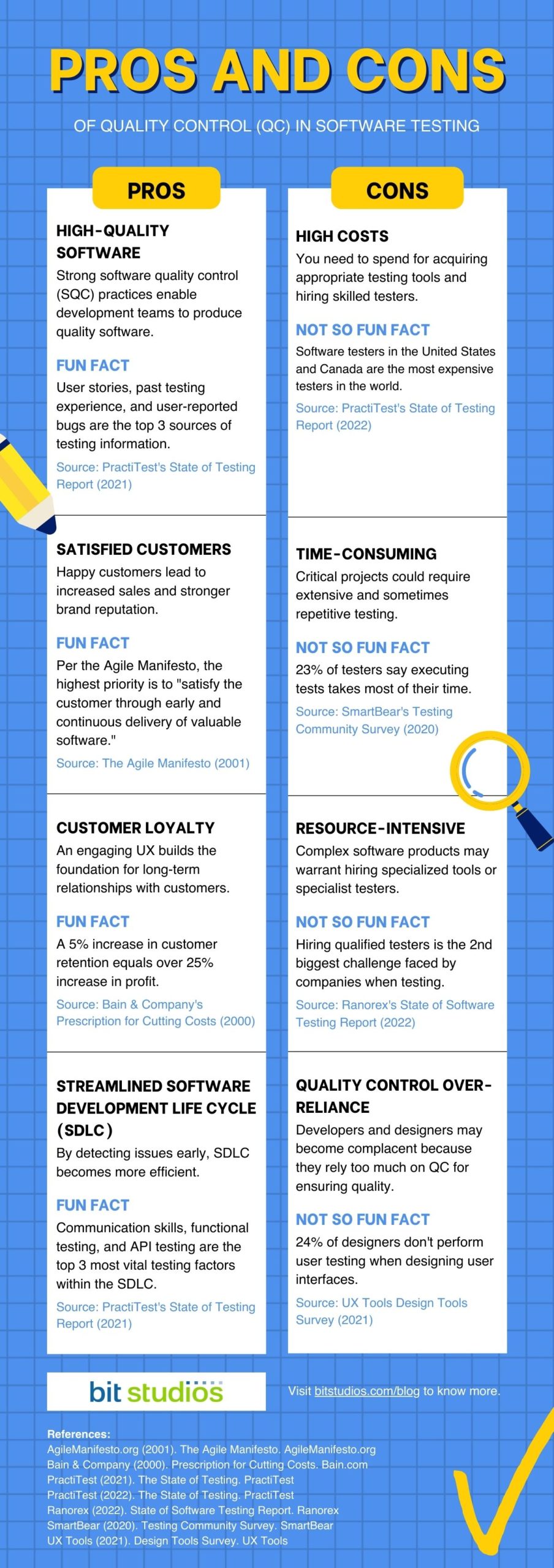Introduction to Quality Control in Software Testing

You might have already heard of quality control software testing before. Sure, it has something to do with checking the quality of software products.
But what is it exactly, and is it the same as quality assurance in software testing?
To answer those questions, we will discuss quality control in software testing.
But first – let’s tackle the basics.
What Is Quality Control in Software Testing?

Software quality control (SQC) refers to ensuring the quality of a software product. Evidently, it is a quality management-focused process.
The QC testing process is not only about preventing bugs and defects in software testing. Above all, it is about meeting the functional requirements of the stakeholders.
Normally, quality control in software happens in the software development life cycle (SDLC).
How exactly is the quality control process executed? And specifically, what activities are included in QA testing? What makes it vital in the software development cycle? How does it affect the software development process? Let us find out in the succeeding sections.
Quality Control Process

The software quality control process falls under a broader concept. This is software quality assurance (QA).
Software quality control is interchangeably used with software quality assurance. Indeed, it looks like they mean the same thing. But technically speaking, they have different definitions.
Software quality control focuses on detecting defects in the actual software product.
However, software quality assurance refers to a series of activities. These are processes or steps that take to check the quality of the software product.
It prevents developers from duplicating efforts. Quality assurance optimizes the software development process.
By defining the best practices, it accelerates the whole software development lifecycle.
In other words, software quality control is product-focused. Meanwhile, QA looks into the whole development process. QA is all about checking the steps taken in the software development cycle.
QA defines standards and methods used in the development. QC verifies and confirms that the best practices were observed.
It is important to note that QA and QC are part of the broader software quality management process.
To know more about SQC activities, proceed to the next section.
Software Quality Control Activities

You can group software quality control activities into two general categories. These are Review Activities and Testing Activities.
Over the following sections, let us go through each category. We will show the activities included in each grouping.
1. Review Activities (Quality Assurance [QA])
Requirement Review
This involves checking if all the required components have been met.
Design Review
It is the testing process of analyzing the building stages of the software product.
Code Review
It refers to the evaluation of the code through various testing methods.
Deployment Plan Review
This requires reviewing the plan for the deployment testing phase.
Test Plan Review
This activity generates test plans to evaluate each field within the software product. Note that a test plan is a document that details the scope, objective, and test design of the test task.
Test Cases Review
A test case is a set of actions executed on software to check if it meets quality requirements. They are usually developed during the test planning stage. It is a must to review each test case for suitability.
2. Testing Activities (Quality Control [QC])
When the testing team finishes the review, they will perform several testing activities. Testing techniques may vary. The specific quality requirements of the software engineering project will determine them.
Unit Testing (also known as Component Testing)
In unit testing, every unit of source code, component, or part is tested if they are working correctly.
Under this context, the term unit could mean different things. It can be a module or an individual function. It could also refer to a procedure, interface, or class. Or it can even be a method in a software product testing life.
It is common to see testing teams using automated tests. These tests are usually prepared by developers. But other testers may opt to execute it via manual testing.
Unit testing makes the development team proactive. It is one of the major advantages of this activity. Defects can be identified early in the software development stage. Those issues could be bugs, coding flaws, or missing elements in a unit.
Integration Testing (also known as Integration & Testing)
Unit testing focuses on determining if each unit works properly. However, integration testing is a different approach. The latter checks if all software modules function well. This is especially true when they are combined with other units.
There are many types of integration testing approaches. The most common are:
- Big-Bang. Test engineers couple the developed modules together and test them as a group.
- Risky-Hardest. This integration testing type checks the riskiest and most difficult module.
- Top-Down
Top-down prioritizes the testing of high-level modules. Then the team will test the lower modules.
- Bottom-Up
This involves integrating and then testing all low-level modules first.
- Sandwich or Mixed
The testing team combines top-down testing with bottom-up testing methods.
System Testing
System testing takes place after the unit testing and integration testing activities. It is a separate testing process that checks the entire integrated system. This step will verify if the integrated system is meeting the project requirements.
System testing should not be confused with integration testing. The latter focuses on how well different units work. Meanwhile, system integration is about identifying the problems in the system’s functionality.
There are three approaches to system testing. We will learn more about them in this discussion.
Destructive Testing
The first approach is destructive testing. Here, you try to disrupt the system or projects to fail in an uncontrolled scenario. The goal is to learn about the system’s limitations.
Non-Destructive Testing
The second approach is non-destructive testing. The aim is to test and engage with the system without causing any damage.
Fault Injection
The last approach is fault injection. This testing process involves intentionally injecting errors into the system. Here, we want to see how the system will react or recover.
Acceptance Testing / User Acceptance Testing
There are several things that user acceptance testing wants to verify. These are the stakeholder’s needs, user expectations, and requirements. It also looks if the software fits into the client’s business processes.
In any software testing life cycle, teams often use test scenarios based on user stories. However, it is possible to do acceptance testing several times. This is because not all cases can be run through a single test case execution.
Acceptance testing in software development processes also varies. The most popular ones are the following:
- Alpha testing
- Beta testing
- Business acceptance testing
- Contract acceptance testing
- Operational acceptance testing
- Regulation acceptance testing
Release Testing
So what happens in release testing? This process tries to find bugs and errors before the software is released.
It begins by establishing a software-released candidate. Take note that the candidate is as good as the final version of the software. It is just that it has not been released yet.
A release testing environment is usually set up to test the software candidate. Although this test environment is controlled, it often involves attempting to break the software. Needless to say, the goal is to fix all the errors that have been recorded before the final deployment. Test reports are generated to record every issue detected from each test execution.
Maintenance Testing
This testing activity is done after the software product has been released. Maintenance testing is performed to check for issues after the following scenarios:
- Planned upgrades and continuous improvement for the software product
- Corrective or emergency changes
- Implementation of additional features
- Data migration
Generally, there are two types of maintenance testing: Confirmation Testing and Regression Testing.
Confirmation testing checks if the changes made in the software are causing problems.
Meanwhile, regression training examines if the changes in the software affect its functionalities.
Next up: Learn about the characteristics of quality control.
Quality Control Characteristics

ISO/IEC 9126 enumerates six essential characteristics of SQC (software quality control). Let us discuss each characteristic further below.
Functionality. Functionality in QC refers to the capabilities of the software product. Functionality can be further broken down into the following sub-characteristics:
- Suitability
- Accuracy
- Interoperability
- Security
Reliability. Reliability measures how the software will behave under specific conditions. Its sub-characteristics are:
- Maturity
- Fault Tolerance
- Recoverability
Usability. It is the degree to which consumers can use the software product to complete specific tasks. Usability can be further broken down into:
- Understandability
- Learnability
- Operability
- Attractiveness
Efficiency. Efficiency checks how the software uses and allocates its resources over time. Efficiency’s sub-characteristics are:
- Time Behavior
- Resource Utilization
Maintainability. Maintainability is the extent to which the software product can be modified. It consists of the following concepts:
- Analyzability
- Changeability
- Stability
- Testability
Portability. It is the ease with which the software product can be used in other test environments. Portability sub-characteristics include:
- Adaptability
- Installability
- Coexistence
- Replaceability
Advantages of Software Quality Control

Embracing software quality control can provide lots of benefits, including:
High-Quality Software Product
Strong SQC practices enable the development team to produce quality software.
Satisfied Customers
Having satisfied customers leads to increased sales and a stronger brand reputation.
An Excellent User Experience That Fosters Customer Loyalty
An engaging UX can build the foundation for long-term relationships with customers.
Streamlined Business Processes
By detecting issues early, the software development life cycle becomes more efficient. It also prevents additional costs.
Conclusion
Quality assurance in software product testing enables teams to deliver top-quality software.
The SQC process consists of various reviews and testing activities. These activities adhere to software quality characteristics set by international standards.
The significant benefits of software quality control are:
- High-quality finished product
- Satisfied customers
- Engaging user experience
- Customer loyalty
- Streamlined business processes
The SQC process consists of various reviews and testing activities. These activities adhere to software quality characteristics set by international standards.

Quality Control in Software Testing FAQs
The test monitoring process and test control are two essential aspects of the testing process. Test monitoring is the act of observing the test environment and the testing phase to ensure that actual progress is running smoothly.
Test control activities on the other hand are the act of maintaining a consistent testing environment and keeping track of all the changes that occur during the testing phase.
The quality assurance testing life cycle is the process and checking actual progress that quality assurance teams use to plan, implement and track their testing efforts. The QA life cycle helps ensure that the software meets its requirements and is free from defects.
There are three types of test monitoring reports in software testing: the test incident report, the test cycle report, and the test summary report.
We’re BIT Studios!
At BIT Studios we specialize in designing, building, shipping, and scaling beautiful, usable products with blazing-fast efficiency



